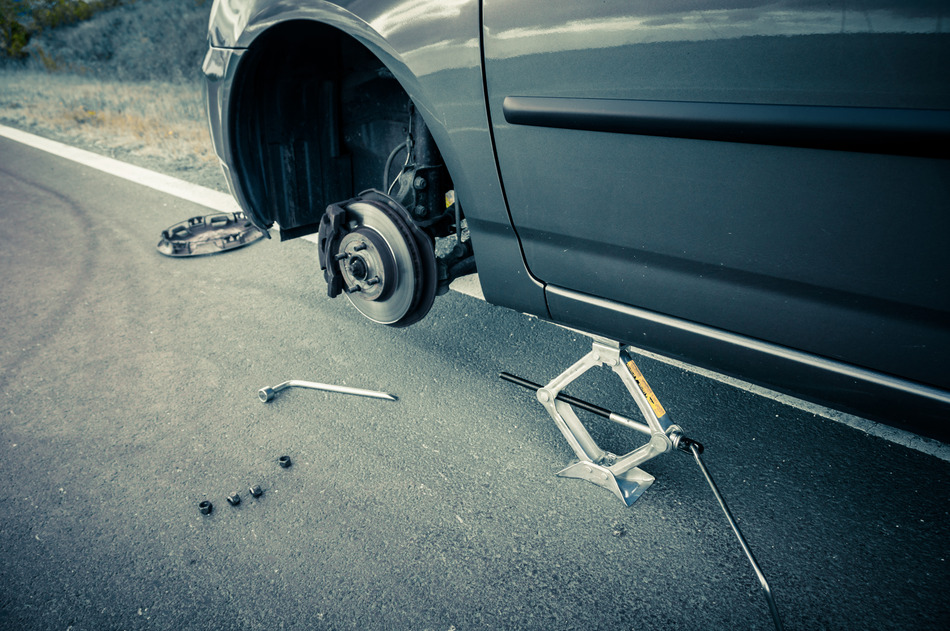If you’ve ever found yourself stuck with a flat tire, you know how frustrating it can be to get back on your way. We’ve created an on-the-go tutorial to help you get back to your life!
Please note – This is a generalized procedure; your vehicle’s procedures may differ slightly, always consult your owner’s manual before attempting to change a tire yourself. While the procedures may vary slightly from vehicle to vehicle, here’s a guide of what to do:
Preparation
- Make sure you’re working somewhere safe – pull far enough of the road to stay clear of traffic. Try to position the vehicle on firm ground – pavement or concrete is preferred.
- Remove any people or large pets from the vehicle – once on the jack, you don’t want anyone moving around in the car at all.
- Remove the spare tire, jack and all required tools from the vehicle – make sure everything you need is within easy reach – in most cases there will be a jack, the spare itself and a tool to remove the lug nuts.
- You want to secure your vehicle from rolling once the jack is in use. If you’ve been using your parking brake on a regular basis, apply it – if you have not, it may be seized, so it’s best to not apply it and have it stick on. Block both the front and rear of the wheel on the opposite corner where the flat tire is – you can use anything suitable lying around; rocks, wood or with vehicles blocks in your kit.
- Remove any wheel cover or trim nuts covering your lug nuts.
Removing The Wheel
- Using the included tool, loosen the nuts slightly (no more than a half turn), do so in a criss-cross pattern so you loosen the nuts evenly.
- Get out your jack and position it under the vehicle – most cars and small vehicles have an arrow or notch along the outer edge of the vehicle where the jack will be used – refer to your manual to be sure.

- Use the jack to lift the vehicle enough to install the spare tire – check by holding the spare up beside the flat tire – you do not want to only lift it high enough to remove the flat; otherwise once the flat is removed you will have to jack up the vehicle further to install the spare.
- I can’t stress enough – do not put any part of yourself under any part of the vehicle while it is only supported by the jack (once the wheel is off). Do not lean on or disturb the vehicle while it is on the jack – the jack supplied with your vehicle is only meant for emergency use and is not as stable as one we would use in the shop.
- Remove the remaining lug nuts and remove the flat tire.
Installing the Spare Tire
- Install the spare tire with the valve stem pointing out (I have witnessed someone trying to install a spare backwards once).
- Reinstall the wheel lug nuts – if they are the open style with no cap, be sure the tapered side goes towards the wheel.
- Snug them up with the vehicle still on the jack; be careful not to knock the vehicle off the jack.
- Lower the vehicle and tighten the lug nuts in a criss-cross pattern until they are snug – do not stand on the tool or use excessive force to tighten the nuts.
- Put the flat and tools back in the vehicle and remove any wheel blocks.
Additional Considerations
- After driving for a few kilometres, stop and check that the lug nuts are tight.
- If your vehicle uses a space saver spare tire (most will say “Temporary Use” right on the side of the tire) do not plan to travel far on it, and keep your speed to under 90 Kph.
- Drive to a trusted auto repair shop. We get a lot of calls at Steelhorse Automotive in London Ontario from stranded motorists and we’ll do whatever we can to help get you back on the road. Give us a call at 519-657-4500!
Check out our video on how to change a flat tire:
We suggest keeping an emergency flat tire kit in your vehicle that contains the following:
- Flashlight with extra batteries
- Mat to kneel on
- Gloves
- Tire pressure gauge
- Tire blocks
- Reflective road triangles
- Jack
- Lug wrench
- Spare tire

